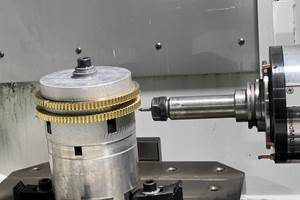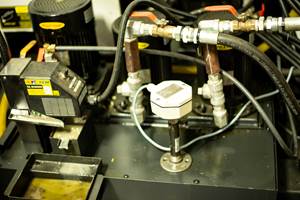Simplifying the Integration of Robotic Automation
The LoadAssistant from Halter CNC Robotics is designed to simplify robotic automation technology in terms of programming, integration and setup.
Share




Editor's Note: Scroll to the bottom of this page to watch the LoadAssistant in action.
Machine-tending robots free shopfloor employees from performing repetitive loading and unloading of parts so they can carry out more valuable tasks, such as setting up other machines, writing part programs, deburring or assembling parts, and so on. They also increase spindle uptime, boosting throughput while enabling shops to realize the benefits of unattended or lights-out machining strategies.
One trend in robotic automation technology is simplification in terms of programming, integration and setup. The LoadAssistant from Halter CNC Robotics is an example of a machine tool loading system that the company believes offers those benefits. Now available in North America, the LoadAssistant is said to easily connect to a shop’s existing CNC machine tool while providing the flexibility and reconfigurability to accommodate a range of jobs, as well as be easily moved from one machine to another. Plus, the company says it is well-suited for small batch sizes, and the average payback period for the system is six to 12 months.
Although the LoadAssistant features a six-axis FANUC robot available in 22-, 44- and 77-pound load capacity versions, the company says the system is more than just a robot arm. Rather, it is said to be a complete, compact robotic loading solution that typically takes just five minutes to connect to a CNC mill or lathe and set up.
The system includes a rotating part-loading table that is available with seven different grid plates to accommodate cylindrical workpieces with diameters ranging from 0.394 to 9.055 inches and prismatic parts measuring 9.055 by 9.055 inches. These universal grid plates are adjustable in height for parts as tall as 9.843 inches and can be used for both milled and turned workpieces. Operators can safely access one half of the rotary table to load new material or remove completed parts while the robot continues to work.
The system’s SmartControl with 15-inch touchscreen display features intuitive, step-by-step programming software that is said to enable quick and simple change-over to new jobs, even for operators with no prior robot-programming experience. Essentially, all an operator needs to do is specify gripper type (two- or three-finger grippers are available to accommodate a range of part geometries) and enter part dimensions. The software supports both milling and turning jobs, and part programs can be saved in the software and called up as needed.
The system does not feature the fencing that commonly surrounds robotic loading arms. Instead, it uses a floor scanner that senses an operator’s presence and safely slows and stops robot motion. That way, the machine tool is accessible to an operator at all times.
The LoadAssistant can be moved from machine to machine using a pallet jack, and the company says quick realignment is possible using three-point, self-centering leveling pads. The system does not require any type of robot interface from a machine tool supplier. Instead, a Halter technician uses a programmable logic controller (PLC) to make the connection between the machine and the LoadAssistant. The machine must be equipped with an automatic door opener, although a Halter technician can install this type of door on machines that don’t have them.
Related Content
Four-Axis Horizontal Machining Doubles Shop’s Productivity
Horizontal four-axis machining enabled McKenzie CNC to cut operations and cycle times for its high-mix, high-repeat work — more than doubling its throughput.
Read MoreInside the Premium Machine Shop Making Fasteners
AMPG can’t help but take risks — its management doesn’t know how to run machines. But these risks have enabled it to become a runaway success in its market.
Read MoreCNC Machine Shop Honored for Automation, Machine Monitoring
From cobots to machine monitoring, this Top Shop honoree shows that machining technology is about more than the machine tool.
Read MoreManaging Coolant with Skimmers, Refractometers and More
Bacteria-infected coolant harms machines and sickens machinists. Coolant management technologies like skimmers and automated systems counter this tendency.
Read MoreRead Next
Building Out a Foundation for Student Machinists
Autodesk and Haas have teamed up to produce an introductory course for students that covers the basics of CAD, CAM and CNC while providing them with a portfolio part.
Read MoreSetting Up the Building Blocks for a Digital Factory
Woodward Inc. spent over a year developing an API to connect machines to its digital factory. Caron Engineering’s MiConnect has cut most of this process while also granting the shop greater access to machine information.
Read More5 Rules of Thumb for Buying CNC Machine Tools
Use these tips to carefully plan your machine tool purchases and to avoid regretting your decision later.
Read More



































